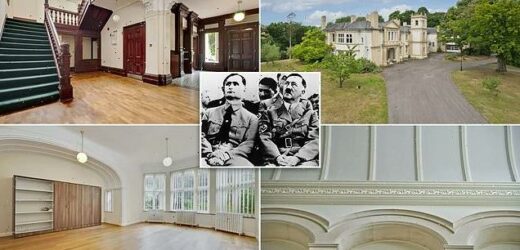Hess’s house for sale: Surrey mansion where Hitler’s deputy Rudolf Hess was kept prisoner after he flew to Britain in bizarre bid to end Second World War could be yours for £15million
- Victorian country house Mytchett Place, near Aldershot, was secret top-security prison codenamed ‘Camp Z’
- The house, which has 12 bedrooms and dates from the late 19th century, is in need of extensive renovation
- Hess was imprisoned an interrogated there after flying to Britain in May 1941 in his Messerschmitt plane
- The Nazi made the futile trip – without the permission of Hitler – in the hope of making a peace proposal
A Surrey mansion where Adolf Hitler’s deputy was kept prisoner after he flew to Britain in a bizarre attempt to end the Second World War could be yours – if you have £15million to spare.
Victorian country house Mytchett Place, near Aldershot, was a secret top-security prison codenamed ‘Camp Z’ that had Hess as its only prisoner. There, he was interrogated by MI6 and also tried to take his own life.
The house, which has 12 bedrooms and dates from the late 19th century, is in need of extensive renovation.
It boasts an entrance porch with huge granite columns, a polished oak staircase, high ceilings throughout and seven panelled reception rooms.
It is set within secluded grounds and gated entrance, with a sweeping drive leading up to it. Evidence of its wartime usage still remains, with pillboxes at the roadside and a guardhouse at the front gates. There are also mounds in the garden where machine-gun emplacements would have been stationed.
Hess was held there after he flew from Germany to Scotland in May 1941 in his Messerschmitt plane before parachuting onto moors south of Glasgow, where he was quickly captured.
The leading Nazi made the futile trip – without the permission of Hitler – in the hope of making a peace proposal to Churchill’s government.
After breaking his leg in a suicide attempt that saw him jump from the top of Mytchett Place’s staircase, Hess was later moved to a military hospital, where he remained for the rest of the war.
A Surrey mansion where Adolf Hitler’s deputy was kept prisoner after he flew to Britain in a bizarre attempt to end the Second World War could be yours – if you have £15million to spare. Above: Hitler and Hess at a Nazi Party meeting in 1939
Victorian country house Mytchett Place, near Aldershot, was a secret top-security prison codenamed ‘Camp Z’ that had Hess as its only prisoner. There, he was interrogated by Mi6 and also tried to take his own life
Hess had been Hitler’s right-hand man throughout the 1930s, but was marginalised after the war broke out.
Concerned about Hitler’s plans to invade Russia, Hess taught himself to fly and then made his trip to Scotland in a Messerschmitt Bf 110. He ran out of fuel and landed in Eaglesham, ten miles south of Glasgow.
He was captured by a local policeman and held in custody. Meanwhile, Hitler was furious at the betrayal and ordered that he be shot if he ever came back to Germany.
Hess was initially held in the Tower of London but was then taken to Mytchett Place to undergo lengthy interrogation.
The perimeter of the house was surrounded by a high fence, barbed wire, alarms and 150 armed sentries who patrolled constantly.
Prime Minister Winston Churchill was keen to get any information out of Hess about Hitler’s regime. He was repeatedly interviewed by intelligence officers, as well as doctors and psychologists.
Whilst his wish to see King George VI was not granted, Hess was visited by the Lord Chancellor John Simon. The Nazi handed him his hand-written peace proposal, which was immediately dismissed by Churchill.
Hess was in a poor mental state and believed he was being poisoned. He also claimed that he could see Hitler’s face reflected in his soup, and that the Holocaust was a Jewish plot.
His suicide attempt failed when he got his leg caught in the balustrade of the staircase. This lessened the impact when he hit the floor, but also broke his leg.
Hess was later moved to Maindiff Court Military Hospital near Abergavenny, Monmouthshire, Wales. He remained there for three years before being tried at Nuremberg.
Whilst he was found guilty of crimes against peace, he was acquitted of crimes against humanity. He spent the rest of his life in Spandau prison in Berlin. He hanged himself in 1987 at the age of 93.
Mytchett Place was one of many large country homes that were commandeered by the government in the war.
The most famous property was Bletchley Park, in Buckinghamshire, where codebreakers including Alan Turing broke Germany’s Enigma code.
After the war, Mytchett Place was used as the headquarters of a British sports car manufacturer, Frazer-Nash Research.
The company built an extension which included a garage, prototype facility and test track in the grounds.
Who was Rudolf Hess? The Nazi who secretly flew to Scotland to try to make peace
Rudolf Hess was born the eldest of three children in Alexandria, Egypt in 1897 to German parents.
He was sent to boarding school in 1908 to study and went on to enrol at the University of Munich in 1919, reading history and economics.
There he learnt about the concept of Lebensraum, ‘living space’, which was used by his professor Karl Haushofer as justification for Germany to conquer land in eastern Europe.
He would later introduce the concept to Hitler, who made it one of the pillars of Nazi Party ideology.
Hess served in the armed forces during the First World War, where his initial posting was against the British at the Battle of the Somme. He was also there for the first Battle of Ypres.
He was awarded both the Iron and Military Merit Cross and discharged in 1918.
Rudolf Hess was Adolf Hitler’s deputy in the Nazi party. He is pictured next to Hitler and other Nazi officials in 1937
After hearing Adolf Hitler speak for the first time at a rally in Munich in 1920, Hess became completely devoted to him.
He shared Hitler’s ‘stab in the back’ theory, that Germany lost the Great War because the Jews and Bolsheviks conspired.
Hess joined the NSDAP in 1920 and worked closer and closer with the leader as time went on.
In November 1923 Hitler decided to try to overthrow the Bavarian leader Gustav Von Kahr with the SA.
A gun-wielding Hitler interrupted Kahr’s speech and called for a national revolution. The following day Hitler and thousands of his supporters marched to the Ministry of War, where shots were fired and 14 marchers and four police officers were killed.
Both Hess and Hitler were sent to Landsberg Prison, where the latter wrote his autobiography Mein Kamph.
He dictated it to Hess and rewarded him by giving him the job of deputy Fuhrer on the pair’s release.
Rudolf Hess was Hitler’s right-hand man in the Third Reich throughout the 1930s and assumed his position as his deputy in April 1933.
He became increasingly marginalised after the Second World War broke out as Hitler became more and more concerned by foreign policy and not internal affairs.
Hess was very concerned about Hitler’s plans to invade Russia, fearing Germany would face war on two fronts.
Hess flew to Britain in a bid to bring Britain to the negotiating table and put an end to the Second World War. Above: Hitler and Hess
He was so concerned he taught himself to fly so he could go to Britain and seek a peace deal from the British Government.
It is thought he flew the Messerschmitt Bf 110 to Scotland in May 1941 in a bid to bring Britain to the negotiating table and put an end to the war.
He ended up running out of fuel and landed in Eaglesham, 10 miles south of Glasgow.
He was captured by a local policeman and held in custody. Meanwhile Hitler was furious at the betrayal.
The British spent a whole year debriefing him before he was sent to a medical institution in Monmouthshire, Wales for three years.
After peace returned in 1945 he was tried for war crimes at Nuremburg and sentenced to life behind bars.
He was found guilty of crimes against peace and conspiring with other German leaders to commit those crimes. He was not convicted of crimes against humanity.
Hess (pictured in 1986) spent 41 years at Spandau Prison in Berlin. There, he disconnected himself with his family and often complained about the food and the state of his heath
Hess (pictured in his prison room in 1986) hanged himself in a summer house that had been built for him in the grounds on August 17 1987. After his death Spandau was demolished to prevent it become a shrine for neo-Nazis
During the trial he developed ‘amnesia’, unable to recall details of what happened during the war.
He was eventually declared sane and fit to stand trial and was forced to admit he had faked the amnesia as a defence tactic.
It took the court two months to decide on sentencing. Most of the Nazis tried at Nuremburg were given the death penalty.
Instead Hess was sentenced to life in prison at Spandau, west Berlin.
He spent 41 years there, where he disconnected himself with his family, and often complained about the food and the state of his heath.
The six other Nazis housed there were eventually released, leaving him the sole prisoner.
He hanged himself in a summer house that had been built for him in the grounds on August 17 1987.
After his death Spandau was demolished to prevent it become a shrine for neo-Nazis.
Source: Read Full Article








